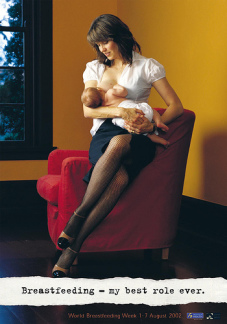
Before you know it, you'll be completely comfortable nursing your baby -- and awed at the amazing dance of mothers and infants that gives humans the best start in life.
The baby’s hold on your areola with her mouth is called “latching on.” Latching on properly will ensure that the baby gets enough milk without hurting your nipples. Follow the steps below to help you and your baby latch on:
1. First, get comfortable.
In the early hours after birth, this will probably mean sitting up in bed. Try sitting up straight and supporting your back with pillows, and keep more pillows nearby to support your arm, neck, or knees. Later on, you will find other spots that feel right, such as the couch or a rocking chair. Eventually, you will able to breastfeed anywhere.
2. Place the baby’s head in the crook of either elbow and support her back and buttocks with your forearm and hand.
The baby should be lying on her side; . do not lie the baby on her back and expect her to turn her head toward you to feed, as this is not a comfortable position in which to swallow.
3. With your free hand, grasp your breast, with the thumb on top, and tickle the baby’s lips or cheek with the nipple.
This will cause a rooting reflex in the baby, if he is hungry, and he will try to reach for the breast with his mouth. It is important that the baby’s mouth be wide open because you want most of the areola, not just the nipple, to go in. A correct nursing position requires this because the baby’s entire tongue stimulates the bottom of the areola, causing the milk ducts to express milk. If the whole areola is not inside the baby’s mouth, the ducts will not receive enough stimulation to send out large amounts of milk. In addition, if the sucking pressure is not fully on the areola, your nipples will be sore.
4. When the baby’s mouth is wide open, press her to you
...(do not lean forward to her) and make sure most of the areola is inside her mouth. If the baby is correctly positioned, you should be able to actually see her tongue sticking out a bit between your breast and her lower lip. If the baby does not achieve the correct position use your forefinger to gently break the seal between your breast and her mouth and remove your nipple. Then try again. It may take a few tries at first.
5. Soon after the baby is sucking properly, you will feel the let-down reflex.
You should then see his jaws moving up and down and a swallowing action. You should not feel pain in your nipples if the baby is positioned correctly. Nurse the baby at least 10 to 15 minutes on the first side and then change to the second side and let him nurse until he falls asleep. He will be done when the breast falls out of his mouth.
6. Burp the baby when she is done eating, or between breasts.
Pick her up, rest her head against your shoulder and gently pat her on the back. You can also try to sit her up, supporting her head, or put her on her tummy in your lap. She may spit up a bit of milk with her burp. This is normal. Most breastfed babies don’t need to burp, but some do. You will soon find which category yours falls into.
PLEASE NOTE: This breastfeeding guide is used here courtesy of Mothering Magazine, which is my all-time favorite parenting magazine. When my oldest was born --17 years ago now -- Mothering was my lifeline to the kind of mother I wanted to be. Full disclaimer: I'm now a parenting expert for Mothering. But I guarantee that if you like this website, you'll like Mothering.com, and I'm honored to give you the highest possible recommendation.




